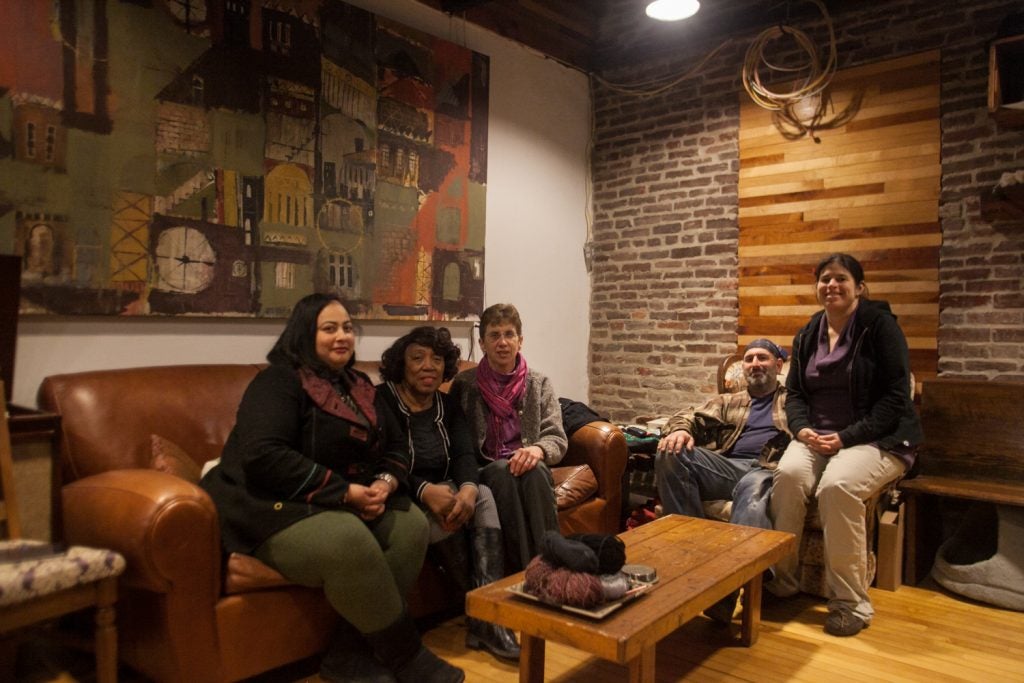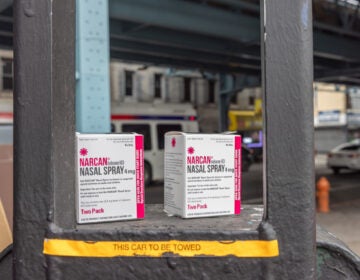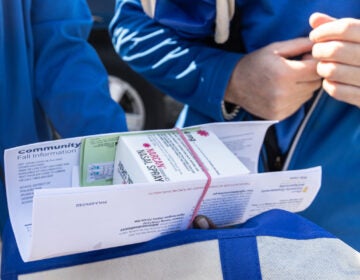Kensington residents: Stronger commitment to neighborhood must accompany any safe-injection site
Residents have a long list of grievances about conditions including used syringes and human feces littering streets, as well as sidewalks blocked by makeshift tents.
Listen 5:10
Amanda Fury listens to a resident's comment during a presentation on neighborhood conditions at a recent meeting of Somerset Neighbors for Better Living. (Joel Wolfram for WHYY)
The February meeting of Somerset Neighbors for Better Living began with the usual update on crime stats from Philadelphia Police Capt. Daniel O’Connor.
A few dozen people sat in the sterile, modern sanctuary of The Rock Ministries church near Kensington Avenue and Somerset Street, listening quietly as O’Connor rattled off figures on theft and armed robberies.
But when the police captain mentioned the camps of homeless heroin users in underpasses along Lehigh Avenue, residents perked up, chiming in with pointed questions. What were police doing to address the chaos in their neighborhood? The fighting in the middle of the night? Children having to see people injecting drugs and exposing themselves in public?
These kinds of questions have lately become a ritual at neighborhood association meetings, said member Amanda Fury.
“They want to come here, ask the police captain, ask whoever they can, to get some motion or some answers,” Fury said.
Residents have a long list of grievances about conditions in the neighborhood, including used syringes and human feces littering streets; sidewalks blocked by makeshift tents; and always having to be on guard for people overdosing. These are problems they say wouldn’t be tolerated in other neighborhoods. The Somerset group has been meeting with city officials since the fall to plead for more help.
But Fury and other members of local civic groups say they’re not getting real solutions yet.
That’s worried them about a proposed safe-injection site, where drug users could shoot up under the supervision of trained medical staff.
“It keeps being dismissed as [an] ‘oh, just not in my backyard’ attitude,” Fury said.
Philadelphia officials announced last month that they’re looking for partners to open such a facility, and many expect the first will be located in Kensington, at the heart of the city’s opioid crisis.
Fury worries about a safe-injection site making the drug-related problems neighbors already deal with worse.
“I feel like a lot of the neighbors don’t have a lot of confidence that the city’s going to take those needs seriously and do things to address them,” Fury said. “And that’s really important too, taking care of the neighborhood.”
Potential neighborhood benefits
Philadelphia’s spokeswoman for health and human services, Alicia Taylor, said the city has taken several measures to address conditions in the neighborhood, including installing additional trash cans, weekly cleanups at homeless encampments, and deploying additional police officers specially trained in dealing with homeless people.
While the city hasn’t identified where a safe-injection site will be located, Taylor said such a site could play a part in addressing residents’ complaints.
“Research shows us that that such a facility will further reduce the prevalence of open-air drug use and litter in public areas by providing individuals with a safe, indoor environment for individuals to go to rather than public spaces,” she said.
In a scientific report commissioned by the city, experts found that the sites can actually reduce public drug use and lead to fewer syringes discarded on the ground, while having no negative effect on drug dealing and overall crime. But they cautioned that much of this evidence comes from just one site in Vancouver, Canada, that was the first to open in North America.
These potential benefits are not changing many minds yet, and residents have long had doubts about the city’s intentions for the neighborhood.
“This has been a forgotten area for a long time,” said Elmira Smith, another member of Somerset Neighbors for Better Living.

Smith said the neighborhood’s problems have been fueled by decades of neglect. Still, she says she would support a safe-injection site opening in Kensington in the right location.
“Every person is important, whether they’re addicted or not,” Smith said.
Smith thinks a safe injection site could gradually turn the neighborhood around if it helped more people get on the road to recovery. Calling them “comprehensive user engagement sites,” city officials said users could access drug treatment and a range of other services at the facilities.
But others are not convinced a safe-injection site would help.
The president of Harrowgate Civic Association, the Somerset group’s neighbor to the north, compared a safe-injection site to resources such as needle exchanges that were introduced in the past.
They helped drug users, but came at a cost to local residents, said Shannon Farrell.
“Now our kids run around in a neighborhood full of needles,” she said. “So they have to come up with a plan that includes us. And what they have said so far doesn’t.”
Farrell opposes opening a safe space to inject drugs until the city can convince her that it’s got the neighborhood’s back. But she admitted that a safe-injection site could save lives. The city estimates a single site could prevent as many as 76 fatal overdoses per year.
Taylor said the city will continue to meet with neighborhood groups and involve them in its decision making before choosing a location. That could be an opportunity to allay the concerns of many who want to help drug users, but keep asking, “What about us?”
—
Bobby Allyn contributed to this story.
WHYY is your source for fact-based, in-depth journalism and information. As a nonprofit organization, we rely on financial support from readers like you. Please give today.





